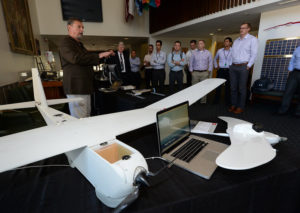
NEWPORT, R.I. (Sept. 9, 2015) Students assigned to U.S. Naval War College (NWC) view static displays of unmanned aerial vehicles (UAV) as part of the NWC’s Unmanned Systems and Conflict in the 21st Century elective course. Scan Eagle, Puma All Environment (AE), Wasp AE, and Switchblade UAVs were on display and provided students first-hand exposure to the systems, capabilities, and applications. The purpose of the course is to acquaint students with the scientific, ethical, and operational issues inherent in the employment of unmanned and robotic systems in the national security context. (U.S. Navy photo by Chief Mass Communication Specialist James E. Foehl/Released) 150909-N-PX557-027
New technologies regularly transform the face of warfare. Innovations like the longbow, the tank, and atomic weapons have changed the face of warfare again and again. Is it possible in Ukraine the world is watching another technological change revolutionizing warfare? Kamikaze drones are being sent by the hundreds to Ukraine from the United States. At Foreign Policy, Christopher Bronk tells readers that Ukraine “needs a whole lot of deadly drones” to win the war. He writes:
As the Russian military stalls in Ukraine, the Kremlin is turning to plan B: terror bombardment of civilians, an attempt to carve off parts of eastern Ukraine and the Black Sea coast, and destruction of Ukraine’s civil and industrial infrastructure. Accordingly, Kyiv needs a plan B as well. It needs long-range offensive strike options that can be deployed en masse and regenerate after attrition by Russian air defenses—something that the Ukrainian Air Force, despite its heroic efforts to date, cannot do.
Long-range, low-cost, self-manufactured kamikaze drones—produced and launched from a variety of locations throughout Ukraine’s nearly Texas-sized territory—would be a game-changer. Kyiv could begin to break Russian sieges through high-volume strikes against command-and-control nodes, artillery units, rotary and fixed-wing airfields, and logistics chains—including in Belarus and Russia itself. Decentralized production and launch capabilities would present Russian forces with fiendish interdiction challenges. Taken together, Ukraine’s ability to strike back at scale for a long period of time would constitute critical first steps toward saving Ukrainian civilian lives now and, hopefully, eventual battlefield victory later.
Kamikaze drones (also sometimes called “loitering munitions”) differ from drones like the United States’ MQ-9 Reaper or Bayraktar TB2 that Ukraine uses now. Rather than being a launch platform for missiles and bombs that return to base after missions, a loitering munition flies into the target itself—sometimes at near-cruise missile ranges—and explodes. Israel’s nearly 40 years of drone experience in conflicts with Syria and the 2020 war between Armenia and Azerbaijan in Nagorno-Karabakh attest to kamikaze drones’ combat effectiveness even against modern air defense systems.
As Russian forces immobilize themselves voluntarily by digging in to consolidate gains and involuntarily through what appear to be compounding logistics supply chain breakdowns, higher-intensity kamikaze drone operations can amplify Ukraine’s demonstrated capabilities in cyberintelligence, signals intelligence, and special operation forces for compounding lethality as Russian capacity for mobile warfare erodes. For now, NATO should move past MiG-29 fighter aircrafts and instead focus on helping Ukraine further scale up its capacity to inflict drone hell on its invaders and facilitate their military defeat.
For tactical strikes, which we define as those occurring at a distance of 150 kilometers (or 93 miles) or less from friendly territory, Ukraine has proved able to creatively generate targeting data as well as successfully and persistently operate Turkish-supplied Bayraktar TB2 drones despite tremendous Russian surface-to-air missile capability. That the Russian Air Force hasn’t swept Ukraine’s unmanned aircraft from the skies reflects yet another of its shortcomings. But Russian air defenses will enjoy greater coverage and concentration as fighting becomes increasingly focused on Ukraine’s east and southeast. Kyiv thus needs dozens more Bayraktar TB2 systems to continue interdiction operations and spotting for its forces’ tube and rocket artillery.
But Bayraktar TB2s alone are insufficient. Kyiv needs a strategic drone warfare concept as well, one with specific political end-state objectives. The Yemen-based Houthi rebels’ disruptive drone warfare campaign against Saudi Arabia and the United Arab Emirates offers a possible model. The Houthis, likely enabled by their Iranian allies, have made enormous strides in using unmanned aerial vehicles (UAS) to impose impactful home front and rear-area costs on foreign attackers. As of December 2021, Houthi forces had reportedly fired more than 850 drones against targets in Saudi Arabia during the preceding seven years. The pace varied, with the Houthis alleging in March 2021 that they unleashed a salvo of 18 armed drones in a single day at various facilities in Saudi Arabia.
Ukrainian forces could likely operate at a higher sustained tempo with more advanced UAS systems given the country’s indigenous technical expertise and, almost assuredly, significant materiel support from NATO members. The United States has already promised 10, 40-kilometer-range (or almost 25-mile-range) Switchblade 600 loitering munitions that can destroy artillery units besieging Ukrainian cities. This offers a useful field test, but Ukraine needs hundreds of these weapons, which would allow Ukrainian forces in the suburbs of Kharkiv, Mariupol, or Odesa to be able to engage most Russian tube and rocket artillery systems and their support vehicles even before they come within range of the city centers. This is a critical near-term challenge for Ukraine’s military. If it can neutralize these systems through the application of counterbattery sensors and UAS, the Russian capacity to menace urban centers could be considerably degraded.
Read more about the Switchblade here and here.
If you’re willing to fight for Main Street America, click here to sign up for my free weekly email.




